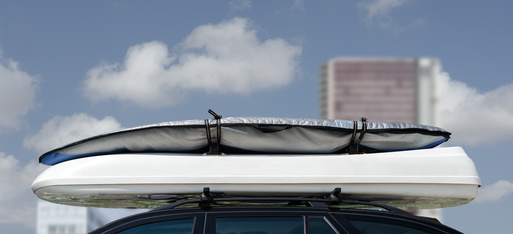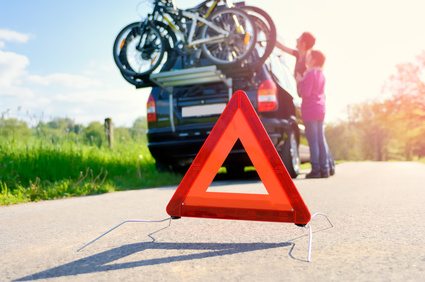For everyday trips, such as going to work, small cars are usually suitable, as they use less fuel and are easier to park. For vacation trips, however, they don't work so well - where would you put all your luggage? No matter how large the car is, families always have this problem, as do sporting types who take along skis or bicycles on vacation. But there's a solution for transporting luggage, other than inside or in the trunk: roof carriers. These can secure not only bikes, kayaks, and winter sports equipment, but also roof boxes. You don't necessarily need a rail - there are alternatives such as attachment points for roof carriers. The base carrier can then be combined with different systems, depending on what you're carrying.
You can find a large selection of roof carriers and other transport gear here.
|
Roof carriers for every need: |
 |
It doesn't have to be a racing bike - bicycle tours are popular everywhere and are great for your health. If you live in a large city, you don't exactly have the nicest cycling routes right at your doorstep. So, pack up the bike and head out into nature. Unfortunately the trunks of most cars are too small to carry bicycles. A bicyle roof carrier is a good alternative. This lets you transport bikes from point A to point B if there isn't enough room in the car. Bicyle roof carriers are fastened onto a base rack. They usually consist of a horizontal section mounted crosswise on the base rack, as well as a diagonal clamping handle that clamps onto the frame of the bicycle. The bicycle tires are fixed to the carrier. When buying a carrier be sure that it's suitable for the size and tire width of your bike. The diameter of the frame is also important. The carrier can often be mounted without any tools.
Universal roof carriers are used for mounting roof boxes or transporting bicycles or kayaks. They can often be locked as a protection against theft. Universal roof carriers are not designed for use on any particular vehicle model, but they fit the cross-section of the roof rail and can be adjusted widthwise. When buying, pay attention to carrying capacity and stable construction. If you aren't sure whether the universal carrier is suitable for your vehicle, opt instead for one that's made to fit your particular vehicle.
Besides bikers and winter sports enthusiasts, kayakers also need a transport solution for their equipment. For this there are special kayak roof carriers. You can also find roof carriers for surfboards and canoes. The kayak holder is mounted on the base rack and is usually well padded. Kayak roof carriers often can be tilted for easy loading and unloading. More expensive models can even have a kind of elevator which lowers the kayak to the level of the door handles so it can easily be unloaded.
Winter sports equipment is best transported with a ski roof carrier. Several manufacturers offer mounting systems for snowboards, even though these often fit in the trunk, which is too small for bulky skis or has no fold-down seat to accommodate them. Ski roof carriers usually look like oversized closure clips for freezer bags. They are fastened to the base rack and opened on the side to insert the skis, and then closed. This variation can hold several pairs of skis. Narrower designs, such as for cross-country skis, are also available.
Many drivers think that an attached roof rail is necessary to mount a roof carrier. That's not actually true. If you want to mount a roof carrier with no rail, several manufacturers offer a suitable option. Here there is a difference between vehicles with and without attachment points on the roof. There are often cover caps in the roof grooves, under which mounting points for the base rack are located. If not, there are roof carriers whose feet are clamped between the door and roof. In more expensive models the rubber door strip is not damaged during use. But in any case, be sure to install it in the right place.
Roof boxes are a practical option for transporting luggage or skis on a vehicle with a small trunk, such as when going on vacation. They vary in shape, size, and method of mounting. Usually a roof rail is required on which the roof box is mounted by means of a bracket or click system, or with a quick-release fastener. Two people should be available for this, as the boxes can weigh more than 20 kg. Heavy objects are better carried in the trunk, while lighter luggage like clothing is fixed in the roof box with lashing straps to prevent sliding. Most roof boxes are lockable to prevent theft.
|
Speed limit Even though in Germany there is no speed limit for driving with a roof box, most manufacturers recommend a maximum speed of 130 km/h. Because weight carried on the roof can affect stability in curves and wind, as well as braking distance, you should adjust your speed to suit the prevailing weather and road conditions. If you notice a change in your car's driving behavior - take your foot off the gas! |
 |
Mounting system
Before buying a roof box, you should be aware of the mounting system. If your car has a roof rail, you need a base rack upon which the roof box can be fixed into place - follow the instructions of the roof box manufacturer! But even without a roof rail, roof boxes can be used if there are attachment points for the roof carrier. Weight-bearing "feet" are screwed into these, to attach to the base carrier.
With a rear rack bicycles can be carried on the trunk lid. There are different systems for vehicles with and without trailer hitches. Hitch carriers are particularly easy to mount and load, though you might need a second license plate, since the one on the car is usually concealed by the bicycles. A conventional rear rack is more sensible and does not require a trailer hitch. But installation can often be somewhat cumbersome, and if you aren't careful you can scratch the finish. Also, this version can significantly increase fuel consumption.
 |
After installing, the trunk lid often can't be opened (with the exception of folding models). Also, there tends to be more wind noise than with roof carriers. When buying, be sure that the particular model is pre-assembled. Folding models, which can be stowed to save room when not in use, are ideal. The lighter the rack is, the easier it will be to install, and usually it can be done without the help of a second person. Also remember to choose rear racks that are compatible with wide tires and modern frame styles, if applicable. |
Rear racks for trailer hitches have 13-pin plugs, so that the lighting on the rack will work with the electrical system of the vehicle. If you have an older vehicle with a 7-pin connector, you may need an inexpensive adapter. Just as important is the load weight on the trailer hitch. Some rear racks hold up to four bicycles. On certain vehicle models, only 50 kg of weight is permitted, and some rear racks already weigh 20 kg by themselves. Also, be careful with carbon frames and use additional padding.